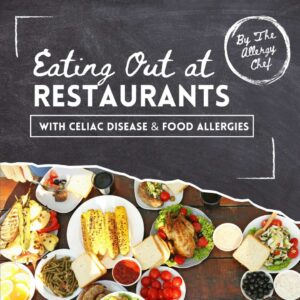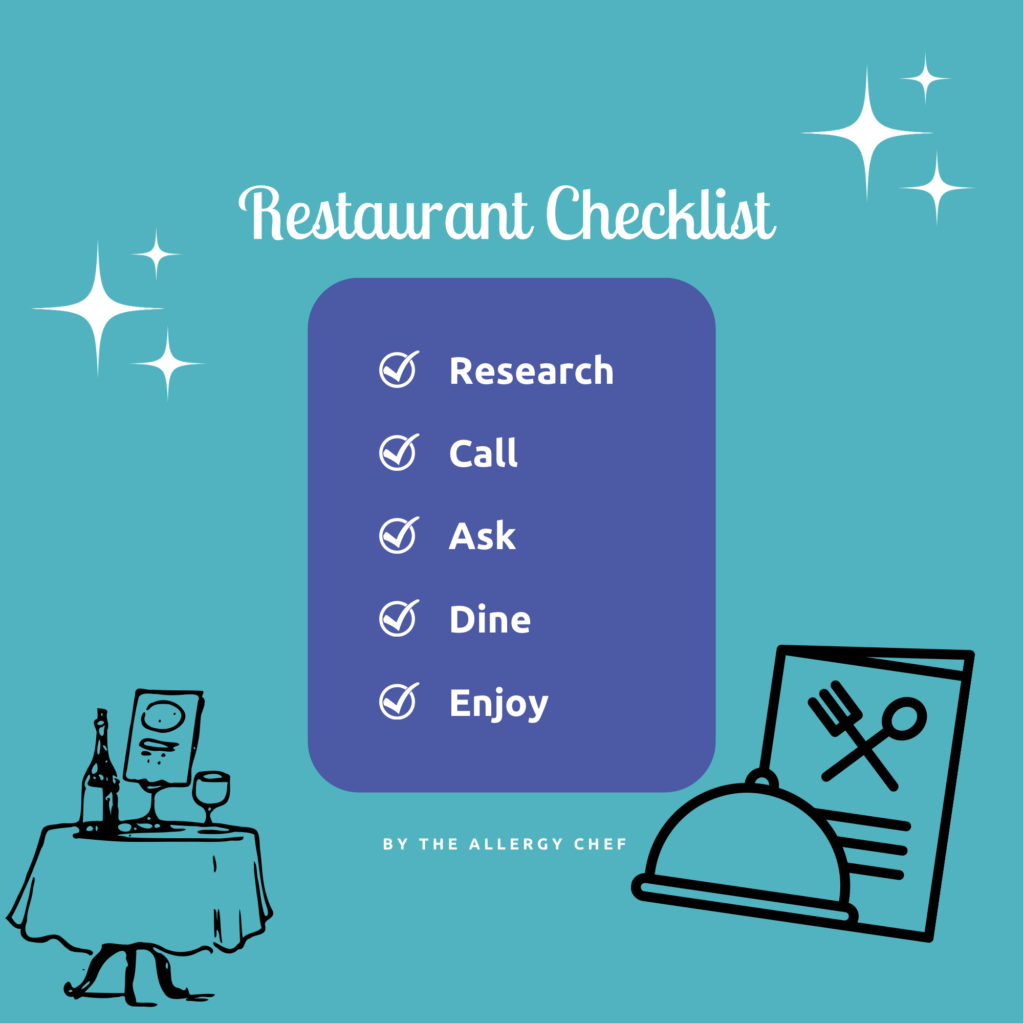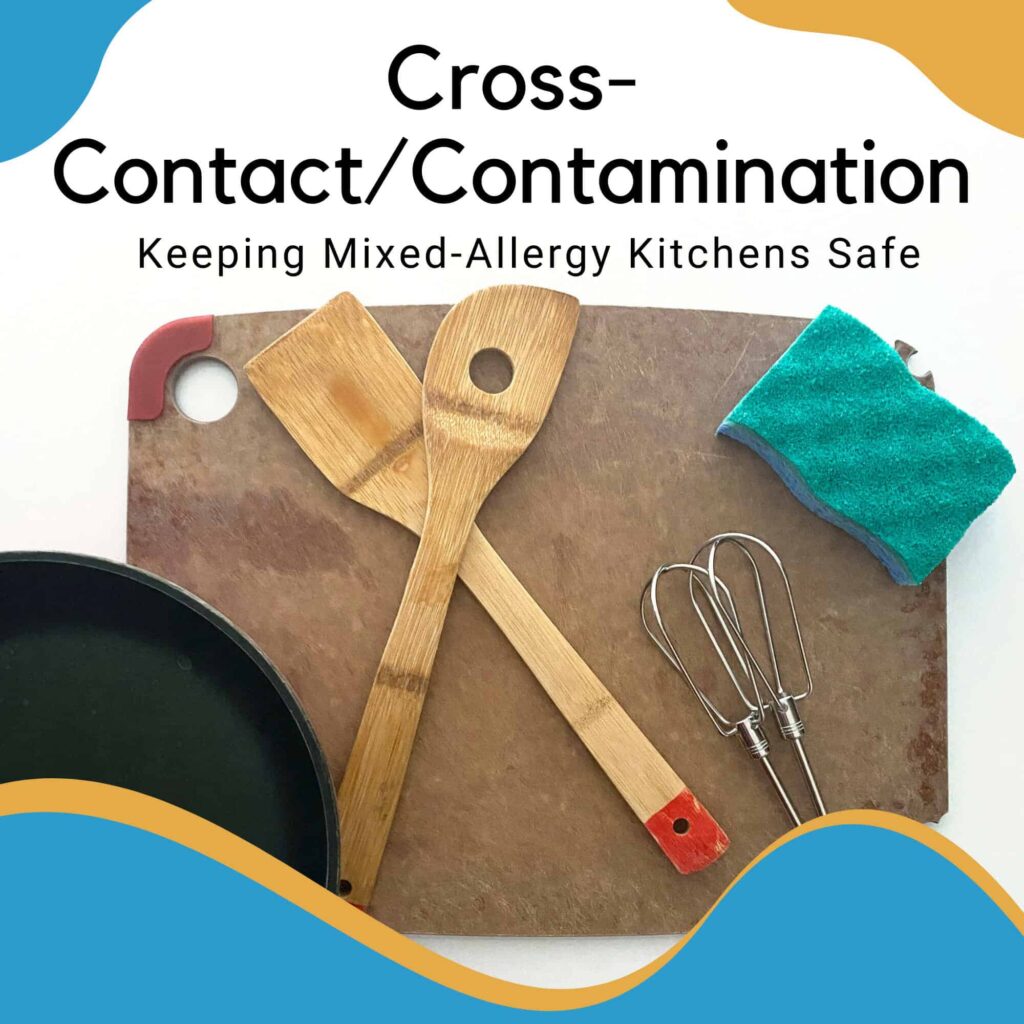How do I eat out at restaurants with food allergies and/or Celiac Disease? This has been a BIG question as of late, so I wanted to put together some thoughts for you all. This article scratches the surface of the topic. If you’d like to learn more about eating out at restaurant with food allergies, RAISE has several resources on the topic.
If you’re looking for a checklist of questions on what to ask when calling about a restaurant, you’ve come to the right place. Click here to download the checklist (also available on RAISE).
Before you Read This Article, I Need you to Think Long and Hard…
About 30% of people with food allergies can’t eat food made on shared equipment with what they’re allergic to. It is my unpopular opinion that these people should NEVER eat at a restaurant that serves their allergens (there are a few exceptions to this). If you get lucky, great. If you’re new, don’t press your luck.
I also encourage you to think about all of the mental and emotional “stuff” you’re going to experience eating out. Many people talk about the anxiety and fear they have to manage when eating out. Is it really worth it? I know for me it’s not. It’s literally 1,000 times easier to just batch cook and have my own “fast food” in the freezer at home.
How do Restaurants Handle Food Allergies?
Each restaurant is going to be different. Some have the head chef and/or shift manager as the point person for people with food allergies.
No matter what the restaurant policy is, clear, open, and consistent communication is key. Without this, your experience is bound to fail.
Communication starts well in advance of when you’d like to eat somewhere. It’s calling and talking to the manager. Let them know the restrictions, that cross contact isn’t an option, and ASK if they can even serve you safely. I have so much respect for any restaurant that honestly tells you ‘no’ up front. They’ve saved you a whole lot of heart ache and potential health crisis.
Restaurants that are prepared to handle food allergies usually have some kind of divided kitchen or dedicated space for free-from foods. Many also have clear visual markers such as different coloured plates, or special toothpicks.
One of the best restaurants I ever saw had a giant line painted down the middle of their kitchen. One side had allergens, the other didn’t. Everything was colour coded, and they were able to keep the food well separated. Was it perfect? No. Was it better than most establishments? Absolutely.
Separate Fryers are a MUST
If you have Celiac Disease or food allergies, the restaurant you go to should have separate fryers for free-from menu items. I’m shocked knowing that even still, there are restaurants that claim they can serve you safely and use shared fryers and grills. Those are hot spots for cross-contact.
Consider Ordering a Small Side
For some people, eating out will be next to impossible if they’re trying to order a complete meal. Some parents may also find it hard to trust a restaurant with their child’s life.
One thing I did for one of the kids: always had him bring his safe food, and if we were at a trustworthy restaurant, he could order a small side of fruit. For some of you, you’ll need to call ahead, even to order a small side. However, this method could help bridge the gap and promote inclusion.
Can a Restaurant Refuse to Serve Someone with an Allergy?
Yes, a restaurant can refuse to cook and serve you food if you have an allergy.
First, BE GLAD. Better to be refused than promised a bill of goods that ends in an allergic reaction. They aren’t refusing you out of spite, they’re doing it for your safety.
Now, if you are at a restaurant with a paying group, a restaurant CAN NOT refuse you access. You are absolutely allowed to bring your safe food and eat along with your group.
Where it can get dicey (and I encourage you to stand up for yourself) is bringing in your own desserts. I’m always quick to stand up for the kids when we have to bring in their birthday cakes and a restaurant wants to charge us a slicing fee. I make it clear that it’s literally impossible for them to serve us a safe cake and this is the only option. They don’t have a safe menu item and it would be wrong to charge us. I have yet to have anyone charge/challenge us on this.
Just remember, a restaurant does not have to cater to someone with a food allergy. However, you’re allowed to bring safe food when you’re with a paying group. I would never personally go into a restaurant alone, with outside food, and expect a free table and service.
Wait, I Have to Sign a Waiver to Eat Here?
In some cases, you may be asked to sign a waiver before a bakery or restaurant will serve you. This is done to protect them in case things don’t turn out right.
Often times, they will communicate to you that they’re going to do everything that they can to keep you safe. Yet, they may tell you in the next breath that because what you’re allergic to is in the kitchen, they can’t make absolute promises.
That waiver of liability is there so that you can then choose to take the risk and dine in without them worrying about being sued.
Can you Sue a Restaurant for an Allergic Reaction?
Yes and no. So, this is a gray area, and it starts with what happened before you ordered. Did the restaurant promise you safety? Did they go over everything with you? Was your ticket clearly marked? And so on. If everything happened perfectly and you still had a reaction, yes. You can sue them, but you may not win.
The reaction may have been outside of their control, which is another reason I tell people in the 30% group to stay home. Let’s say the restaurant promised you a nut free meal, yet, you had a reaction. They traced everything back in their kitchen and there were no nuts present when your meal was made. Turns out, one of the suppliers has a delivery guy that eats nuts whilst driving the truck and delivered the bread that morning. There was nothing the restaurant could have done about that and no, you can’t sue them. They did everything in their power to keep you safe.
The thing about eating out at restaurants with Celiac Disease and food allergies is that it’s always going to be a gamble. There’s only ONE truly safe restaurant available to you: One that doesn’t serve your allergen at all. If XYZ was never in the facility, there’s a really good chance you’ll be OK.
Do Restaurants Have to Provide Allergen Information?
Yes, legally, a restaurant must provide allergen information here in the United States for the US top 9 allergens. It’s important to note that whilst wheat is one of the top 9, gluten is NOT. You can read all about gluten here.
Restaurants will need to be able to tell you if any of the top 9 are in the product. They might be able to tell you on the spot about shared equipment. If you need to know about ingredient sourcing, you’ll need to talk with them weeks before visiting so they can truly research their vendors.
Do Menus Have to Show Allergens?
No, legally, the physical menu here in the United States does not need to indicate allergens. It’s common these days to see some kind of allergen or dietary marking on a menu, however, this is all voluntary. I’ve seen how the menu system works in Europe and it’s amazing. Here in the States, we are sorely lacking.
Many restaurants now offer an allergen menu. It usually has less items to choose from and is pretty clear about what’s in the dish.
Even though the menu a customer receives doesn’t have to have the information, the restaurant still has to be able to provide the information upon request. I’ve seen several establishments that have a gigantic binder with every single last detail of every recipe on the menu. This allows them to open it up and show a customer who may have allergy and special diet questions.
The reason they have these binders instead of having it on the menu: cost and flexibility. Menus can change, as can ingredients. It would be expensive to re-print menus every time. A streamlined binder makes the process easier.
Fine Dining: It Could be a Nightmare
I’m sure you’re all familiar with farm to table eating. Here in the San Francisco Bay Area we have quite a few restaurants with Michelin stars. One of these restaurants happens to source most of their ingredients from farms that are safe for me. Whilst I’d love to dine there, it’s still not possible.
This restaurant has menus that change weekly, and daily. They tell you up front that the only substitution available is vegetarian.
What that tells me is they have a lot of prep work done in advance, and it would be near impossible for them to make me a one-off dish. This way of doing things also means I can’t call weeks in advance to talk with the chef about the safest day to dine because everything they’re doing is hyper local and seasonal.
Are all fine dining establishments like this? Nope. However, I’d like for you to keep that in mind, especially if you want the local experience.
Food Allergy Training for Restaurants
The good news is that training is offered for restaurants these days. It’s not a legal requirement, but it’s out there. The real issue is the turnover rate for staff at restaurants. The only way to bridge this gap in the future will be to require any food service staff to have allergy training in addition to their food handler’s license before working with food.
I’ve personally gone through the training, just to see what they were teaching the workers. I can tell you this: it’s lacking in some areas. The training covers most ground, but not all ground. It also does not take into account people like myself that have non-traditional reactions to food.
Let’s just say, there’s a lot of reasons why I think some people just need to eat at home for their own health and safety.
In a Recent Survey…
Recently, FAACT shared that in a survey of 100 employees from different restaurants, 42% reported they had food allergy training. Don’t get too excited yet.
25% of the people who responded to the survey thought that removing nuts from a dish made it nut free/safe. Please let that really sink in.
Even if you do everything right to find a great place to dine, there is still a human factor that can cause issues once you’ve placed your order.
How Allergens can be Transferred in the Food Service Environment
Honestly, I could write a book about this, but I don’t want to keep you all day. First, watch this video which SHOWS you a form of cross contact. Then, read more in this article on cross contact in kitchens.
From there, think about each and every step your plates, cooking utensils, and food take through a kitchen. Think about all the hands your food will pass through from the farmer to the server. When you do that, it’s easy to see all of the pitfalls.
A few common ways allergens are transferred in the food service environment:
- Staff who consume allergens and don’t wash up well after eating
- Dishwashers (more on that below)
- Cutting boards
- Non-stick pans
- Hand towels (chefs wear them, touch them, then touch food again and again)
- Grills & fryers
Let’s talk dishwashers. We were at an event once, years ago, and the kitchen hosting us took our dishes to sanitize them. Notice I didn’t say clean. When the dishes were returned, food particles were still clearly visible on the cutting board.
These are the little ways that allow for allergens to be transferred all over a kitchen, and this has the potential to ruin your dining experience.
What Questions can be Asked to Chefs About Cross-Contact?
There are a lot of questions you’ll want to ask the chef and/or manager as you select a place to dine. RAISE has this handy guide: Eating Out Checklist. It’s an easy way to make sure you didn’t forget anything when contacting a restaurant.
If you’re not a RAISE Member, click here to download the Restaurant Checklist.
What is the Difference Between Cross-Contact and Cross-Contamination?
In the food (service) safety world, cross-contamination refers to pathogens, bacteria, and food borne illnesses. Example: a chef places raw chicken on a cutting board to prep it for service. After completion, raw celery which will be served raw is placed on the same cutting board. There’s contamination from the raw chicken that can cause a food borne illness.
Cross-contact refers to allergens specifically. For instance, if a chef uses a spoon in the sauce containing dairy, then transfers the spoon to the dairy free sauce. In this case, a pathogen was not transferred because the sauce is cooked. However, depending on how you look at this example, cross-contamination IS cross-contact for many. In other words, a food borne illness still happens. Hope that makes sense.
Just know that if you’re talking to a food service worker and ask about “wheat cross-contamination” they may not understand what you’re really asking about which in their language is “wheat cross-contact”.
Can you be Allergic to a Restaurant?
Is it weird that I think this is such a fun question? I think this is the nerd in me talking right now. So here’s the thing. Yes, you can be allergic to a restaurant, but it might not be how you’re thinking.
Let’s say you have an airborne allergy to dairy and the restaurant makes a lot of pasta and pizza. You may have a reaction and think you’re allergic to the restaurant. You’re actually allergic to the dairy that’s present.
In another example, someone like myself with severe MCS (Multiple Chemical Sensitivity) might go into a restaurant, take a deep breath, and have an allergic reaction. Am I truly allergic to the brick and mortar restaurant? Probably not. It’s more likely that I’m allergic to all of the cleaning supplies, perfumes (from staff and guests), and so on.
Now, some people are allergic to specific building materials and can’t touch them, or even be around them. Fun fact: years ago when we had to have the interior of our house painted, we used (expensive) corn free paint for this exact reason. I personally cannot be around a lot of building materials most people are fine with. Am I allergic to the restaurant? One could easily argue that I am.
The takeaway here is that you’re most likely allergic to something on site, not the building itself.
How are Allergic Reactions Best Avoided in a Restaurant?
I hope this article has helped you start to see how you can avoid allergic reactions at restaurants. One method we use personally is to find places that are naturally free-from what we can’t eat. Alternatively, some restaurants use the ingredients sparingly.
A good example of this is Kid Two going to sushi restaurants. So long as he doesn’t eat the condiments, knows what’s in sauces, and communicates clearly, he can usually get something safe to eat at a sushi restaurant or poke bar.
For a lot of people, raw vegan restaurants and Paleo restaurants are able to meet their needs. 100% gluten free restaurants are popping up all over the country as well.
Be sure to use apps such as Spokin or Find Me Gluten Free to make finding a safe restaurant much easier.
Final Thoughts & Additional Resources
Hopefully you have a better understanding of HOW to go about eating out a restaurant if you have Celiac Disease or food allergies. I know I’ll personally probably never eat at a restaurant again due to the number of restrictions I have, including a severe corn allergy. For others who are managing a smaller list, I hope you’re able to find a place that can serve you safely.
- Eating Out at Restaurants with Celiac Disease & Food Allergies Checklist
- Hidden Sources of Allergens
- RAISE Podcast Episode 22: My Unpopular Restaurant Opinion
- RAISE Podcast Episode 1: Eating Out at Restaurants






